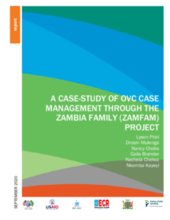Executive Summary
Zambia’s HIV prevalence is currently estimated at 11.1% among adults aged 15–49 years and 1.1% among children aged <15 years20. The Zambia National HIV/AIDS/STI/TB Council estimates that 10% of Zambia’s population (over 1.3 million children under age 18 years) are at high risk of being orphaned or vulnerable due to the impact of the HIV epidemic. Since the epidemic began, an estimated 250,000 children and adolescents have already been orphaned as a result of HIV/AIDS. The Zambia Family (ZAMFAM) project’s aim is to improve the care and resilience of vulnerable populations while supporting HIV epidemic control in Zambia. Expanded Church Response (ECR) has been implementing the ZAMFAM program since 2015, working with 88 sub-partners including faith/communitybased organizations (F/CBOs) and government line ministries.
ZAMFAM used the case management approach which tracks the beneficiary from identification to graduation. The case management cycle involves a ZAMFAM methodology of scaled up community engagement from the first step of orphans and vulnerable children (OVC) identification, followed by assessment, case opening, child and family support planning, support and referral services, monitoring and review and case closure. An assessment process is used to determine the specific needs of each child and household, creating an individualized care plan with action steps to address the areas of highest vulnerability. ZAMFAM directly provides or delivers referrals to existing services to meet the basic needs of OVC through home visits and one-stop delivery points at community level by trained community volunteers (CVs). These services address primary health care which includes HIV prevention, care and treatment, education, psychosocial needs, child protection, nutrition, parenting skills and economic strengthening.
As the project comes to an end in 2020, ECR engaged Population Council (PC), to conduct a qualitative case study of the ZAMFAM program. A case study approach was employed to understand actors, perceptions and document best practices by the ZAMFAM program. Focus group discussions were held with young men and women program beneficiaries as well as with male and female cargivers of beneficiary households. Key informant interviews were held with identified stakeholders who included program staff, representatives of government ministries and ZAMFAM implementing partners. All interviews and focus group discussions were audio recorded and transcribed verbatim in Nvivo soft. Thematic content analysis was used to identity key themes and link them to the study objectives. Results of the assessment indicate that program beneficiaries viewed the ZAMFAM program as having made a positive contribution to the lives of OVC in the communities where ZAMFAM was implemented. Testimonials from beneficiaries’ perspectives reflect high knowledge of HIV prevention, care, and management in communities where ZAMFAM was implemented as well as identify educational support that include payment of school fees and provision of school requisites as benefits of the program. Additionally, the beneficiary home visitations from CVs, which provided a comprehensive service package, were also hailed by beneficiaries and key stakeholders.
Perspectives of beneficiaries and stakeholders were sought in addition to a detailed review of key program documentation to identify best practices and lessons for future programming. These best practices are discussed in detail in the report and recommendations are shared. Based on our findings, the study makes the following recommendations for future programming that focuses on OVC and their caregivers as well as CVs.
1. Programs that offer a comprehensive package of services to vulnerable households through one-stop models ensure that program beneficiaries receive the maximum benefit for such outcomes. There is, however, need to identify modalities to incentivize volunteers who are often locals from study communities and upon whom program success is dependent. Investment in training these volunteers is intended to benefit the program beneficiaries and ensure sustainability of the intervention beyond its program life span.
2. Low-cost, high impact interventions, including encouraging the use of local produce for nutritional gain, allow beneficiary communities to continue with the use of such knowledge ensuring sustainability of the interventions. Cooking demonstrations and preservation of local food produce implemented by ZAMFAM in study sites allowed households to maximize nutritional benefits using commodities already available in their communities for the benefit of OVC households and people living with HIV.
3. In managing beneficiary expectations, community programs need to clearly define and communicate to beneficiaries the kind of support to be provided to the community and the criteria to be used for providing such services to the respective households. As was the case with ZAMFAM, volunteers who often support such projects were equipped to identify and respond to needs of OVC utilizing referrals and linkages to other programs or activities when services are not within the project scope. However, linkages and referral mechanisms should be strengthened between F/CBOs and other service providers for continued service provision.
4. Community Saving Groups have proven to be a useful approach to foster economic prosperity and resiliency at the household level. As such, future programs that introduce these models should consider providing initial capital to enable low earning households access credit for business start-up. In addition to this, we also noted from discussions with caregivers and CVs that groups that were able to combine savings group activities with other income generating activities, like chicken rearing and farming, provided better lending packages to their members. However, there is need to ensure that groups are equipped to develop guidance for screening group members and managing untrustworthy members to prevent them from destabilizing the group.

